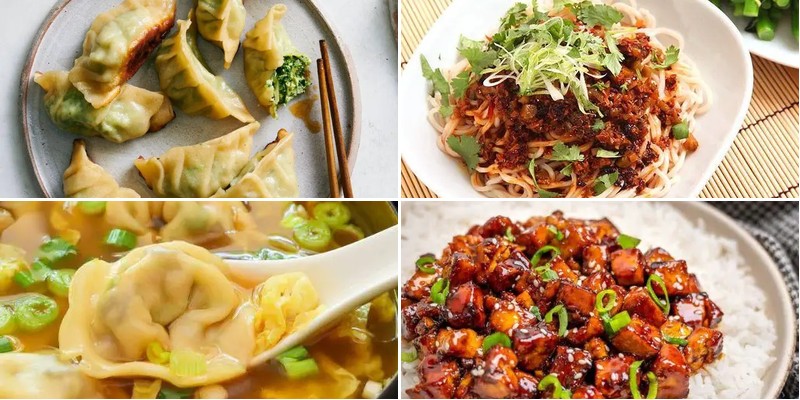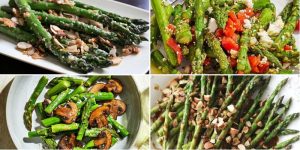Vegan Chinese cuisine offers a world of vibrant flavors and satisfying meals that will delight your taste buds! Whether you’re craving quick weeknight dinners, comforting classics, or exploring new plant-based favorites, this collection has something for everyone. Get ready to discover 28 delicious recipes that bring the magic of Chinese cooking right to your kitchen—let’s dive in and start cooking!
Kung Pao Tofu
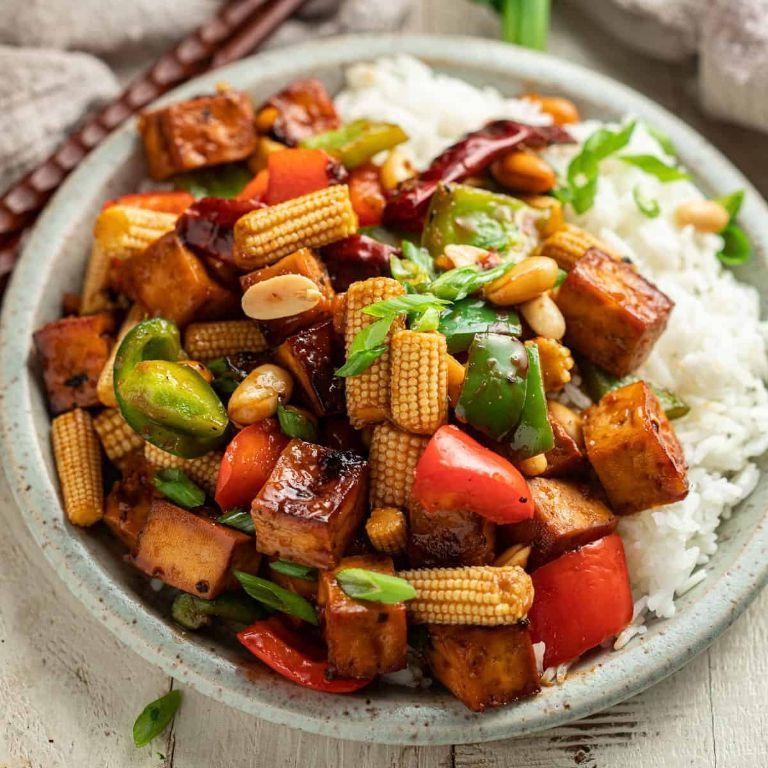
Wandering through the quiet kitchen this afternoon, I found myself craving something with both comfort and spark—something that would fill the space with warmth and the gentle sizzle of memory. Kung Pao Tofu came to mind, a dish that balances softness and crunch, heat and sweetness, like a conversation between old friends. It’s simple to prepare, yet each step feels like a small meditation, a way to slow down and savor the process.
3
servings20
minutes15
minutesIngredients
– 1 block (14 ounces) extra-firm tofu, pressed and cubed
– 2 tablespoons toasted sesame oil
– 3 dried red chilies, stems removed and lightly crushed
– 1/2 cup unsalted roasted peanuts
– 3 cloves garlic, minced
– 1 teaspoon freshly grated ginger
– 1/4 cup low-sodium soy sauce
– 2 tablespoons rice vinegar
– 1 tablespoon hoisin sauce
– 1 teaspoon granulated sugar
– 2 teaspoons cornstarch, dissolved in 1/4 cup cold water
– 2 scallions, thinly sliced
– 1/4 cup water chestnuts, drained and sliced
Instructions
1. Press the tofu block between paper towels with a heavy skillet for 15 minutes to remove excess moisture, then cut into 3/4-inch cubes.
2. Heat 1 tablespoon toasted sesame oil in a large non-stick skillet over medium-high heat (350°F surface temperature).
3. Add tofu cubes in a single layer and pan-fry for 4–5 minutes per side until golden brown and crisp-edged.
4. Transfer tofu to a plate and reduce heat to medium.
5. Add remaining 1 tablespoon toasted sesame oil to the skillet.
6. Toast dried red chilies and peanuts for 1–2 minutes until fragrant and peanuts are lightly golden.
7. Stir in minced garlic and grated ginger, cooking for 30 seconds until aromatic but not browned.
8. Pour in low-sodium soy sauce, rice vinegar, hoisin sauce, and granulated sugar, stirring to combine.
9. Return tofu to the skillet along with sliced water chestnuts, tossing gently to coat.
10. Pour in cornstarch slurry and simmer for 2–3 minutes until sauce thickens and glazes the ingredients.
11. Fold in sliced scallions and cook for 30 seconds until just wilted.
12. Remove from heat and let rest for 2 minutes before serving. Perhaps the most satisfying part is that first bite—the way the crisp tofu gives way to tenderness, the peanuts adding a earthy crunch against the gentle heat of chilies. Pair it with jasmine rice to soak up the glossy sauce, or serve it alongside steamed bok choy for a complete, comforting meal that feels both nourishing and celebratory.
Vegan General Tso’s Cauliflower

Kindling memories of takeout nights, this vegan interpretation transforms humble cauliflower into something truly extraordinary, where crisp florets meet that signature sweet-heat glaze we all crave. Each bite carries the comforting familiarity of classic takeout while feeling entirely new and nourishing.
3
servings15
minutes34
minutesIngredients
– 1 large head cauliflower, cut into 1.5-inch florets
– ¾ cup cornstarch
– ½ cup all-purpose flour
– 1 cup cold sparkling water
– ¼ cup avocado oil
– 3 tablespoons toasted sesame oil
– 4 cloves garlic, minced
– 1 tablespoon freshly grated ginger
– ½ cup low-sodium tamari
– ⅓ cup pure maple syrup
– 2 tablespoons rice vinegar
– 1 teaspoon gochujang paste
– ½ teaspoon Szechuan peppercorns, freshly ground
– 2 scallions, thinly sliced
– 1 tablespoon toasted sesame seeds
Instructions
1. Preheat oven to 425°F and line a baking sheet with parchment paper.
2. Whisk together cornstarch, all-purpose flour, and cold sparkling water until smooth.
3. Dip each cauliflower floret into the batter, allowing excess to drip off.
4. Arrange battered florets in a single layer on the prepared baking sheet.
5. Bake for 22 minutes until edges begin to crisp and turn golden.
6. Heat avocado oil in a large wok over medium-high heat until shimmering.
7. Carefully add baked cauliflower and fry for 3-4 minutes until deeply golden.
8. Transfer cauliflower to a wire rack using tongs.
9. Reduce heat to medium and add toasted sesame oil to the same wok.
10. Sauté minced garlic and freshly grated ginger for 45 seconds until fragrant.
11. Whisk in low-sodium tamari, pure maple syrup, rice vinegar, and gochujang paste.
12. Simmer sauce for 4 minutes until slightly thickened and glossy.
13. Return cauliflower to the wok and toss gently to coat in the sauce.
14. Sprinkle with freshly ground Szechuan peppercorns and toss once more.
15. Transfer to serving dish and garnish with thinly sliced scallions and toasted sesame seeds.
Effortlessly elegant, the cauliflower maintains a satisfying crunch beneath its lacquered glaze, while the Szechuan peppercorns create that distinctive tingling sensation on the tongue. Serve it over jasmine rice with steamed bok choy for a complete meal, or pack it cold for next-day lunches where the flavors have deepened overnight.
Szechuan Eggplant Stir-Fry
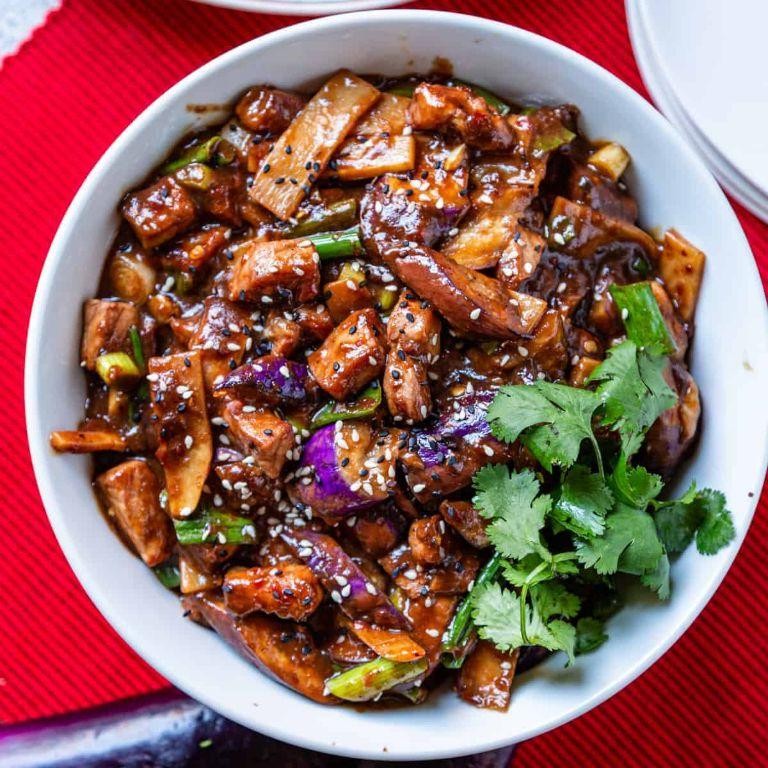
Kindly, as autumn leaves begin their slow descent outside my window, I find myself craving dishes that warm from within—this Szechuan eggplant stir-fry, with its gentle heat and velvety texture, has become my quiet companion on these cooling evenings.
4
servings30
minutes10
minutesIngredients
– 1 ½ pounds Chinese eggplant, cut into 2-inch batons
– 3 tablespoons cold-pressed peanut oil
– 4 cloves garlic, minced
– 1 tablespoon freshly grated ginger
– 2 dried Szechuan chilies, deseeded and crushed
– 1 tablespoon Szechuan peppercorns, lightly toasted
– 2 tablespoons Chinkiang black vinegar
– 1 ½ tablespoons tamari
– 1 teaspoon raw cane sugar
– ½ cup homemade vegetable stock
– 1 teaspoon toasted sesame oil
– 2 scallions, thinly sliced on the bias
Instructions
1. Place eggplant batons in a single layer on a parchment-lined baking sheet and salt generously; let rest for 25 minutes to draw out moisture.
2. Pat eggplant thoroughly dry with paper towels to ensure proper searing.
3. Heat peanut oil in a carbon steel wok over medium-high heat until it shimmers, about 375°F.
4. Add eggplant in a single layer and sear undisturbed for 3 minutes until golden brown on one side.
5. Flip each piece carefully and cook for another 2 minutes until tender but not mushy.
6. Push eggplant to the wok’s sides, creating a well in the center.
7. Add garlic, ginger, Szechuan chilies, and peppercorns to the center; toast for 45 seconds until fragrant.
8. Combine all ingredients by stirring gently from the center outward.
9. Pour Chinkiang vinegar around the wok’s edges to deglaze, scraping up any browned bits.
10. Add tamari, cane sugar, and vegetable stock; bring to a simmer.
11. Reduce heat to medium and cook for 4 minutes until sauce lightly coats the back of a spoon.
12. Drizzle with sesame oil and toss to combine.
13. Transfer to a serving dish and garnish with scallions.
Beyond the initial warmth, this dish reveals layers—the eggplant collapses into silkiness against the tingling peppercorns, while the black vinegar provides a dark, complex acidity. I sometimes serve it over jasmine rice with a soft-poached egg, the yolk mingling with the glossy sauce to create something entirely new.
Vegan Chinese Dumplings
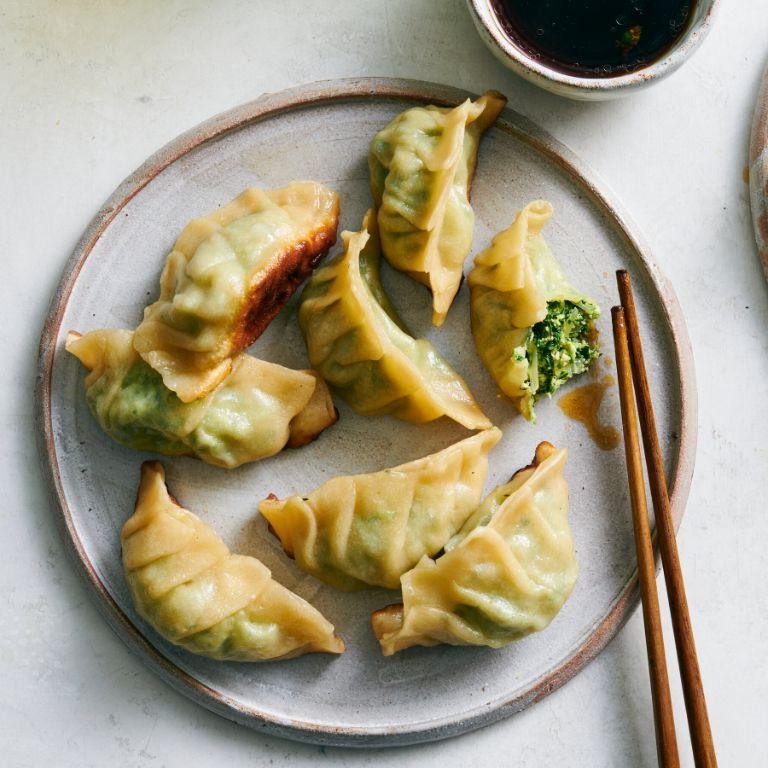
A quiet morning finds me reflecting on the simple comfort of homemade dumplings, their delicate folds holding stories and flavors that transcend any dietary boundary. These vegan Chinese dumplings carry the gentle wisdom of plant-based cooking, where each ingredient speaks with intention rather than force. There’s something deeply meditative about crafting them by hand, a slow dance between filling and wrapper that nourishes both body and spirit.
24
dumplings30
minutes13
minutesIngredients
- 2 cups finely chopped king oyster mushrooms
- 1 cup shredded Napa cabbage, lightly salted and pressed
- ½ cup minced Chinese chives
- 2 tablespoons toasted sesame oil
- 1 tablespoon freshly grated ginger root
- 2 cloves garlic, microplaned
- 1 tablespoon tamari
- 1 teaspoon rice vinegar
- 24 round vegan dumpling wrappers
- 2 tablespoons high-heat avocado oil
- ½ cup filtered water
Instructions
- Combine king oyster mushrooms, pressed Napa cabbage, Chinese chives, toasted sesame oil, ginger, garlic, tamari, and rice vinegar in a glass mixing bowl.
- Stir the filling mixture with a wooden spoon for exactly 2 minutes until thoroughly integrated and slightly glossy.
- Place one dumpling wrapper on your palm and spoon 1 tablespoon of filling into the center.
- Dip your fingertip in water and trace the outer edge of the wrapper to moisten.
- Fold the wrapper in half over the filling, pressing edges together firmly to create a half-moon shape.
- Create 5-6 small pleats along the sealed edge, pressing each pleat firmly to ensure no air pockets remain.
- Repeat with remaining wrappers and filling, keeping finished dumplings under a damp cloth to prevent drying.
- Heat avocado oil in a heavy-bottomed skillet over medium-high heat until it shimmers, about 350°F.
- Arrange dumplings in a single layer in the hot skillet, pleated sides up, leaving ½ inch between each.
- Pan-fry for 3 minutes until bottoms develop a deep golden-brown crust.
- Pour filtered water carefully into the skillet until it reaches one-third up the sides of the dumplings.
- Immediately cover with a tight-fitting lid and reduce heat to medium-low.
- Steam for 8 minutes until wrappers become translucent and filling is visible through the dough.
- Remove lid and continue cooking for 2 more minutes until all water evaporates and bottoms re-crisp.
What emerges are delicate parcels with translucent skins that reveal the marbled beauty within, their bottoms offering a satisfying crackle against tender steamed tops. The king oyster mushrooms provide a remarkably meaty texture while the ginger and garlic whisper through each bite. Try serving them arranged like lotus petals around a central dish of black vinegar dipping sauce, creating an edible mandala that honors both tradition and innovation.
Sweet and Sour Jackfruit
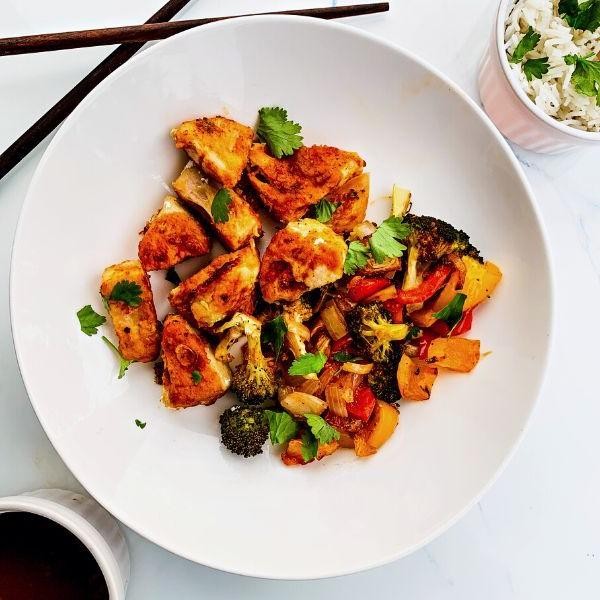
Just thinking about how some of the most comforting dishes emerge from the quietest kitchen moments, this sweet and sour jackfruit feels like one of those gentle discoveries that slowly unfolds its layers. Jackfruit, with its remarkable ability to absorb flavors while maintaining its tender structure, creates a dish that’s both nostalgic and quietly surprising. There’s something deeply satisfying about the way the sweet and sour elements meld together, offering a balance that feels both familiar and new.
3
servings15
minutes25
minutesIngredients
– 2 cups young green jackfruit in brine, drained and rinsed
– 1/4 cup avocado oil
– 1/2 cup finely diced yellow onion
– 2 cloves garlic, minced
– 1/4 cup rice vinegar
– 1/4 cup coconut sugar
– 2 tablespoons tamari
– 1 tablespoon tomato paste
– 1/2 cup vegetable stock
– 1 teaspoon arrowroot powder, dissolved in 1 tablespoon cold water
– 1/4 teaspoon freshly cracked black pepper
– 1/4 teaspoon smoked paprika
– 1 tablespoon toasted sesame oil
Instructions
1. Pat the young green jackfruit pieces completely dry with paper towels to ensure proper browning.
2. Heat the avocado oil in a large cast-iron skillet over medium heat until it shimmers, about 2 minutes.
3. Add the jackfruit to the skillet in a single layer, cooking undisturbed for 4–5 minutes until golden brown on one side.
4. Flip each piece carefully using tongs and cook for another 4 minutes until evenly browned and slightly crispy.
5. Transfer the jackfruit to a plate lined with paper towels to absorb excess oil.
6. In the same skillet, add the finely diced yellow onion and sauté over medium-low heat for 6–7 minutes until translucent and fragrant.
7. Stir in the minced garlic and cook for 1 minute until aromatic but not browned.
8. Whisk together the rice vinegar, coconut sugar, tamari, tomato paste, and vegetable stock in a small bowl until fully combined.
9. Pour the sauce mixture into the skillet, scraping up any browned bits from the bottom with a wooden spoon.
10. Simmer the sauce uncovered for 5 minutes over medium heat until slightly reduced.
11. Gradually stir in the arrowroot slurry while continuously whisking to prevent clumping.
12. Cook for 2–3 minutes until the sauce thickens to a glossy, coating consistency.
13. Return the jackfruit to the skillet, tossing gently to coat each piece evenly with the sauce.
14. Season with freshly cracked black pepper and smoked paprika, stirring to incorporate.
15. Drizzle with toasted sesame oil just before removing from heat.
16. Remove the skillet from the heat and let rest for 2 minutes to allow flavors to meld. Remarkably tender yet satisfyingly meaty in texture, the jackfruit carries both the bright acidity and subtle sweetness with each bite. Serve it over jasmine rice where the sauce pools gently underneath, or tuck it into warm tortillas with crisp shredded cabbage for a contrasting crunch that highlights the complex flavor profile.
Moo Shu Vegetables
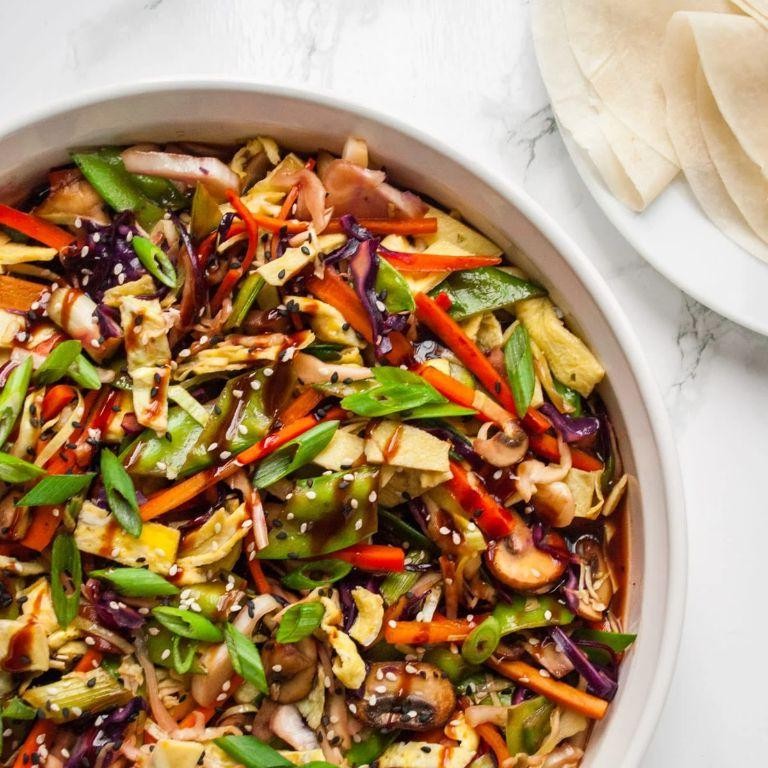
Beneath the gentle steam rising from the wok, there’s a quiet comfort in watching vibrant vegetables transform, their colors deepening as they soften into something greater than themselves. This moo shu vegetables recipe feels like a slow, deliberate meditation—a way to honor each ingredient’s journey from crisp to tender, from separate to harmonious. It’s the kind of meal that asks you to pause, to notice the subtle shifts in texture and aroma as everything comes together.
8
rolls15
minutes9
minutesIngredients
– 2 tablespoons toasted sesame oil
– 3 large pasture-raised eggs, lightly beaten
– 1 cup thinly sliced shiitake mushroom caps
– 2 cups finely shredded napa cabbage
– 1 cup julienned carrots
– 1/2 cup matchstick-cut bamboo shoots
– 3 cloves garlic, minced
– 1 tablespoon freshly grated ginger
– 2 tablespoons tamari
– 1 tablespoon rice vinegar
– 1 teaspoon organic cane sugar
– 8 small flour tortillas, warmed
– 2 tablespoons hoisin sauce
Instructions
1. Heat 1 tablespoon toasted sesame oil in a large wok over medium-high heat until it shimmers.
2. Pour the lightly beaten pasture-raised eggs into the wok and swirl to form a thin layer.
3. Cook the eggs for 45 seconds until the edges begin to set, then gently scramble with a spatula into soft curds.
4. Transfer the egg curds to a clean plate and set aside.
5. Add the remaining 1 tablespoon toasted sesame oil to the wok and heat until fragrant.
6. Add the thinly sliced shiitake mushroom caps and sauté for 2 minutes until they release their moisture and begin to brown.
7. Stir in the finely shredded napa cabbage and julienned carrots, cooking for 3 minutes until the cabbage wilts slightly but retains some crunch.
8. Incorporate the matchstick-cut bamboo shoots, minced garlic, and freshly grated ginger, stirring constantly for 1 minute until aromatic.
9. Return the egg curds to the wok and gently fold into the vegetable mixture.
10. Combine tamari, rice vinegar, and organic cane sugar in a small bowl, then pour over the vegetables.
11. Toss everything together for 1 minute until the sauce evenly coats all components and lightly glazes the vegetables.
12. Remove from heat and let rest for 1 minute to allow flavors to meld.
13. Spread 1/2 teaspoon hoisin sauce onto each warmed flour tortilla.
14. Spoon the vegetable mixture evenly down the center of each tortilla.
15. Fold the bottom edge of each tortilla up over the filling, then roll tightly from one side to form a neat cylinder.
Crisp-tender vegetables play against the soft egg curds in a way that feels both substantial and delicate. The hoisin’s sweet depth balances the tamari’s umami richness, creating layers that unfold with each bite. For a beautiful presentation, slice the rolled tortillas diagonally and arrange them like blooming flowers on a platter, revealing the colorful filling within.
Vegan Mapo Tofu
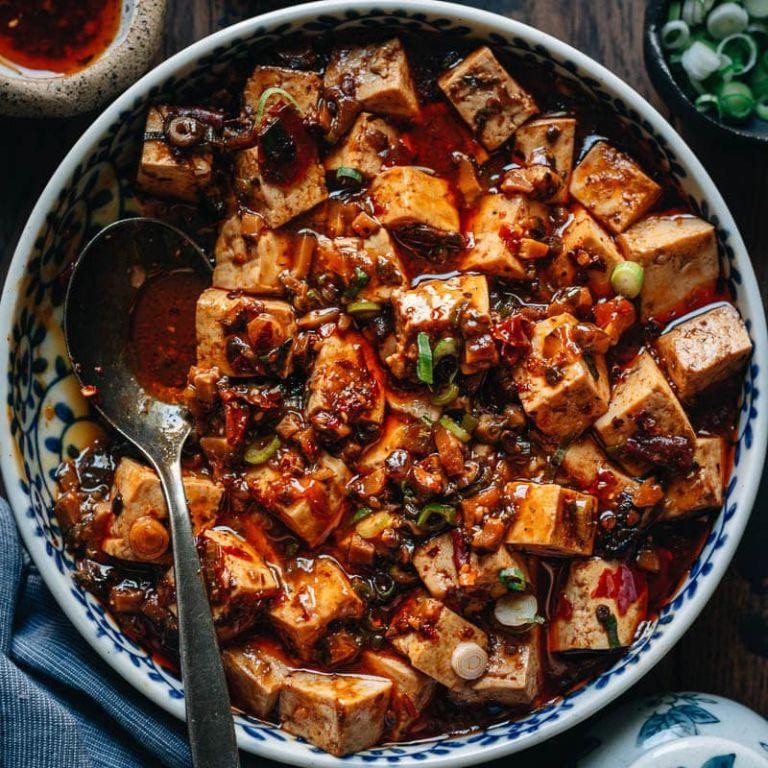
Often, when the autumn chill begins to settle in the air, I find myself craving something that warms from the inside out—something with depth and comfort, yet gentle in its heat. This vegan mapo tofu, with its silken cubes swimming in a fragrant, umami-rich sauce, has become my go-to for such evenings. It’s a dish that feels both nourishing and deeply satisfying, a quiet celebration of texture and spice.
2
servings15
minutes10
minutesIngredients
– 1 block (14 ounces) silken tofu, gently drained
– 2 tablespoons cold-pressed sesame oil
– 3 cloves garlic, finely minced
– 1 tablespoon freshly grated ginger
– 2 tablespoons fermented black bean paste
– 1 tablespoon gochujang (Korean red pepper paste)
– 1 teaspoon Sichuan peppercorns, lightly toasted and ground
– 1 cup vegetable stock, warmed
– 1 tablespoon tamari
– 1 teaspoon organic cane sugar
– 1 tablespoon cornstarch, dissolved in 2 tablespoons cold water
– 2 scallions, thinly sliced on the bias
Instructions
1. Cut the silken tofu into ¾-inch cubes and set them on a paper towel-lined plate to absorb excess moisture.
2. Heat the cold-pressed sesame oil in a wide skillet over medium heat until it shimmers.
3. Add the finely minced garlic and freshly grated ginger, sautéing for 60 seconds until fragrant but not browned.
4. Stir in the fermented black bean paste and gochujang, cooking for another 90 seconds to deepen their flavors.
5. Sprinkle in the ground Sichuan peppercorns, toasting for 30 seconds until aromatic.
6. Pour in the warmed vegetable stock, tamari, and organic cane sugar, bringing the mixture to a gentle simmer.
7. Carefully slide the tofu cubes into the skillet, shaking the pan to nestle them into the sauce without breaking.
8. Simmer for 5 minutes, occasionally spooning sauce over the tofu to infuse it.
9. Stir the cornstarch slurry and drizzle it evenly over the simmering sauce, cooking for 2 minutes until thickened and glossy.
10. Turn off the heat and fold in the sliced scallions, reserving some for garnish.
Ultimately, the tofu emerges custardy-soft against the velvety, pungent sauce, with the Sichuan peppercorns leaving a tingling warmth that lingers pleasantly. Serve it over jasmine rice to soak up every last drop, or alongside steamed bok choy for a contrasting crunch.
Chinese Eggplant with Garlic Sauce
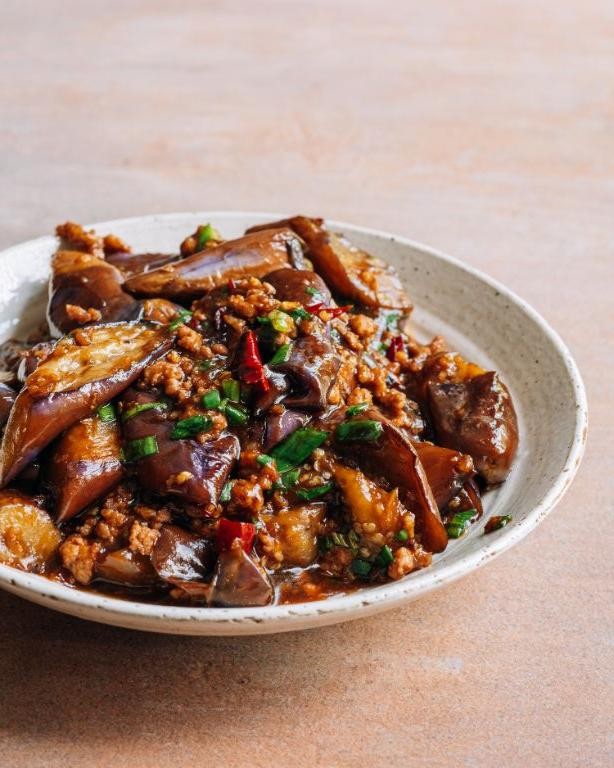
Sometimes the simplest dishes hold the deepest memories, like this Chinese eggplant with garlic sauce that takes me back to rainy afternoons in my grandmother’s kitchen, where the sizzle of the wok meant comfort was minutes away. Soft purple skins yielding to gentle pressure, releasing that distinctive earthy sweetness that only develops with patient cooking. Today, I find myself returning to this recipe whenever I need that same quiet reassurance, the kind that comes from transforming humble ingredients into something extraordinary.
4
servings15
minutes15
minutesIngredients
– 2 medium Chinese eggplants (approximately 1½ pounds total), cut into 2-inch batons
– 3 tablespoons peanut oil, divided
– 6 cloves fresh garlic, finely minced
– 1 tablespoon freshly grated ginger root
– 2 tablespoons Shaoxing cooking wine
– 3 tablespoons light soy sauce
– 1 tablespoon Chinkiang black vinegar
– 2 teaspoons granulated sugar
– 1 teaspoon cornstarch dissolved in 2 tablespoons cold water
– 2 scallions, thinly sliced on the bias
– 1 teaspoon toasted sesame oil
Instructions
1. Cut the Chinese eggplants into uniform 2-inch batons, approximately ¾-inch thick, to ensure even cooking.
2. Heat 2 tablespoons of peanut oil in a large wok over medium-high heat until it shimmers and reaches 350°F.
3. Add the eggplant batons in a single layer, working in batches if necessary to avoid overcrowding.
4. Sear the eggplant for 3-4 minutes per side until golden brown and slightly softened, turning with tongs for even browning.
5. Transfer the seared eggplant to a plate lined with paper towels to drain excess oil.
6. Reduce the heat to medium and add the remaining 1 tablespoon of peanut oil to the wok.
7. Sauté the minced garlic and grated ginger for exactly 45 seconds until fragrant but not browned.
8. Pour in the Shaoxing wine and deglaze the wok, scraping up any browned bits from the bottom.
9. Add the light soy sauce, black vinegar, and granulated sugar, stirring continuously until the sugar dissolves completely.
10. Return the seared eggplant to the wok, gently tossing to coat with the sauce.
11. Cover the wok and simmer for 5 minutes over medium-low heat until the eggplant becomes tender but still holds its shape.
12. Create a slurry by whisking the cornstarch with cold water until completely smooth.
13. Drizzle the cornstarch slurry into the sauce while stirring constantly to prevent lumps.
14. Cook for 1 additional minute until the sauce thickens to a glossy consistency that coats the back of a spoon.
15. Remove from heat and fold in the sliced scallions and toasted sesame oil.
16. Transfer to a serving dish immediately to prevent further cooking.
For the final texture, the eggplant should yield completely to gentle pressure while maintaining structural integrity, creating a luxurious mouthfeel that contrasts beautifully with the glossy, pungent sauce. Freshly steamed jasmine rice provides the perfect neutral canvas to showcase the complex interplay of savory, sweet, and tangy notes, though it also makes a remarkable filling for lettuce cups when you want something lighter. Finding that perfect balance where the eggplant nearly melts while the sauce clings to each piece is what transforms this from mere sustenance to culinary meditation.
Soy Sauce Noodles with Tofu
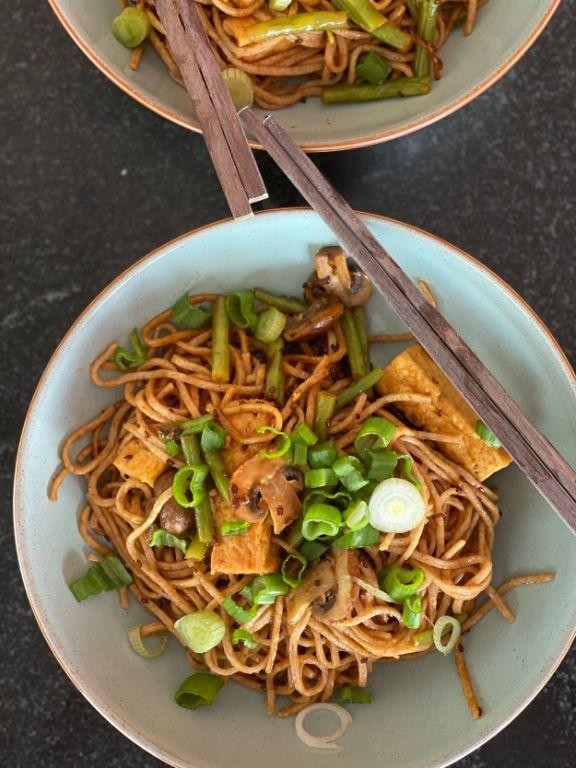
For those quiet evenings when the world outside slows to a gentle hum, there’s something profoundly comforting about the simple ritual of preparing soy sauce noodles with tofu. Folding silken tofu into glossy noodles creates a meal that feels both nourishing and deeply personal, a quiet celebration of textures and subtle flavors that soothe the soul.
3
servings15
minutes20
minutesIngredients
– 8 ounces dried udon noodles
– 14 ounces firm tofu, pressed and cubed
– 3 tablespoons toasted sesame oil
– 4 cloves garlic, thinly sliced
– 1/4 cup tamari soy sauce
– 2 tablespoons mirin
– 1 teaspoon freshly grated ginger
– 2 scallions, thinly sliced on bias
– 1 tablespoon toasted sesame seeds
Instructions
1. Bring 4 quarts of water to a rolling boil in a large stockpot.
2. Add udon noodles and cook for 8-10 minutes until al dente, stirring occasionally to prevent sticking.
3. Drain noodles thoroughly in a colander, reserving 1/4 cup of pasta water.
4. Heat toasted sesame oil in a large wok over medium-high heat until it shimmers.
5. Add cubed tofu and pan-fry for 4-5 minutes until golden brown on all sides.
6. Transfer tofu to a plate lined with paper towels to absorb excess oil.
7. Reduce heat to medium and add thinly sliced garlic to the same wok.
8. Sauté garlic for 45-60 seconds until fragrant but not browned.
9. Whisk together tamari soy sauce, mirin, and freshly grated ginger in a small bowl.
10. Pour sauce mixture into the wok and bring to a gentle simmer.
11. Add reserved pasta water to the sauce and simmer for 1 minute to emulsify.
12. Return cooked noodles and pan-fried tofu to the wok, tossing to coat evenly.
13. Cook for 2-3 minutes until the sauce clings to the noodles.
14. Remove from heat and fold in bias-cut scallions.
15. Garnish with toasted sesame seeds before serving.
The noodles emerge slick and glossy, each strand carrying the deep umami of tamari while the tofu provides creamy contrast against the chewy texture. For a striking presentation, serve in shallow bowls with extra scallions scattered across the top like spring confetti.
Vegan Hot and Sour Soup

Just now, as autumn leaves begin their slow descent outside my window, I find myself craving the complex warmth of this soup, a vegan reinterpretation that honors traditional flavors while embracing plant-based simplicity. Journeying through each spoonful feels like tracing memories across seasons, where sharp and soothing notes dance in delicate balance.
4
servings20
minutes25
minutesIngredients
- 8 cups rich vegetable stock, preferably homemade
- 4 dried shiitake mushrooms, rehydrated and thinly sliced
- 1 cup firm tofu, pressed and cut into ¼-inch cubes
- ½ cup bamboo shoots, julienned
- ¼ cup rice vinegar
- 3 tablespoons tamari
- 2 tablespoons chili oil
- 1 tablespoon freshly grated ginger
- 2 teaspoons toasted sesame oil
- 1 teaspoon white pepper, freshly ground
- 3 tablespoons cornstarch
- ¼ cup cold water
- 2 scallions, finely sliced on the bias
- Fresh cilantro leaves for garnish
Instructions
- Combine vegetable stock, sliced shiitake mushrooms, and grated ginger in a heavy-bottomed stockpot over medium-high heat.
- Bring the mixture to a gentle simmer, then reduce heat to maintain a steady bubble at 190°F for 15 minutes to fully infuse the mushroom essence.
- Add cubed tofu and julienned bamboo shoots, simmering for exactly 8 minutes until tofu firms slightly but remains tender.
- Whisk rice vinegar, tamari, chili oil, and white pepper in a small bowl until fully emulsified.
- Slowly pour the seasoning mixture into the simmering soup while stirring clockwise with a wooden spoon to ensure even distribution.
- Create a cornstarch slurry by vigorously whisking cornstarch with cold water in a separate bowl until no lumps remain.
- Drizzle the slurry into the soup in a thin, steady stream while continuously stirring, watching for the liquid to transform from cloudy to translucent within 2-3 minutes.
- Remove the pot from heat and stir in toasted sesame oil, which should form delicate iridescent pools on the surface.
- Ladle the soup into warmed bowls, ensuring equal distribution of solid ingredients in each serving.
- Garnish with bias-cut scallions and fresh cilantro leaves arranged in a loose circular pattern.
Lingering on the tongue, the soup delivers silken tofu against crisp bamboo shoots, while the broth itself carries layered heat that builds gradually rather than assaults. Last night I served it in handmade ceramic bowls with a side of steamed jasmine rice, watching the steam rise like gentle ghosts in the evening light. Each variation—perhaps with enoki mushrooms or a splash of black vinegar—feels like discovering the recipe anew.
Stir-Fried Bok Choy with Garlic
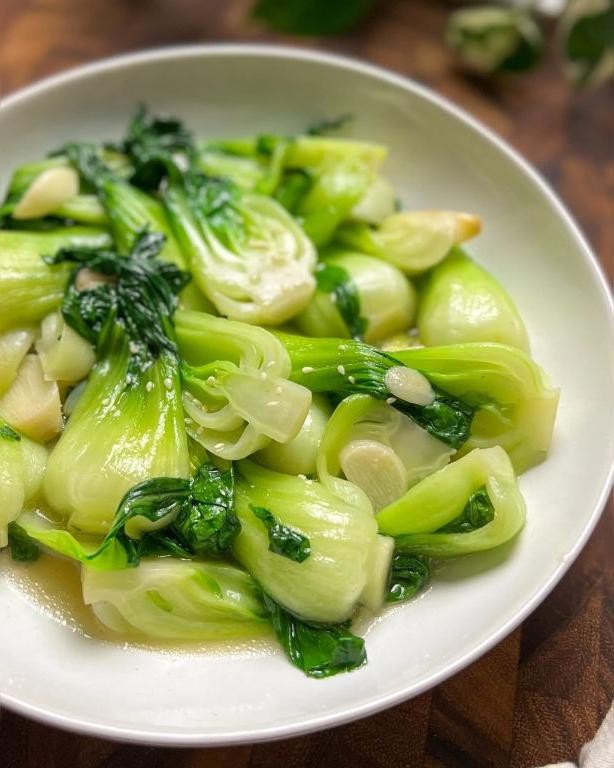
Remembering how my grandmother would move through her kitchen, I find myself drawn to the quiet rhythm of preparing vegetables, the way bok choy leaves unfurl like delicate green fans in the washing bowl.
4
servings10
minutes4
minutesIngredients
– 1 pound baby bok choy, trimmed and separated
– 3 tablespoons cold-pressed avocado oil
– 4 large garlic cloves, thinly sliced
– 1 tablespoon tamari
– 1 teaspoon toasted sesame oil
– ¼ teaspoon fine sea salt
Instructions
1. Thoroughly wash the baby bok choy under cold running water, paying special attention to the base where soil accumulates.
2. Pat the bok choy completely dry using a clean kitchen towel to ensure proper searing.
3. Separate the white stems from the green leaves, cutting the stems into 1-inch diagonal pieces.
4. Heat the cold-pressed avocado oil in a large carbon steel wok over high heat until it shimmers, about 375°F.
5. Add the thinly sliced garlic cloves and cook for exactly 15 seconds until fragrant but not browned.
6. Immediately add the bok choy stems and stir-fry for 2 minutes until slightly translucent around the edges.
7. Incorporate the green leaves and continue stir-frying for 1 minute until just wilted.
8. Drizzle the tamari around the perimeter of the wok to caramelize upon contact with the hot surface.
9. Add the toasted sesame oil and fine sea salt, then toss everything together for 30 seconds.
10. Transfer immediately to a serving platter to prevent residual cooking.
Usually, the contrast between the crisp stems and silken leaves creates a beautiful textural dance, while the garlic infuses every bite with its gentle warmth. Consider serving it alongside jasmine rice to catch the savory tamari glaze, or fold it into rice noodles for a quick lunch that feels both nourishing and elegant.
Vegan Wonton Soup
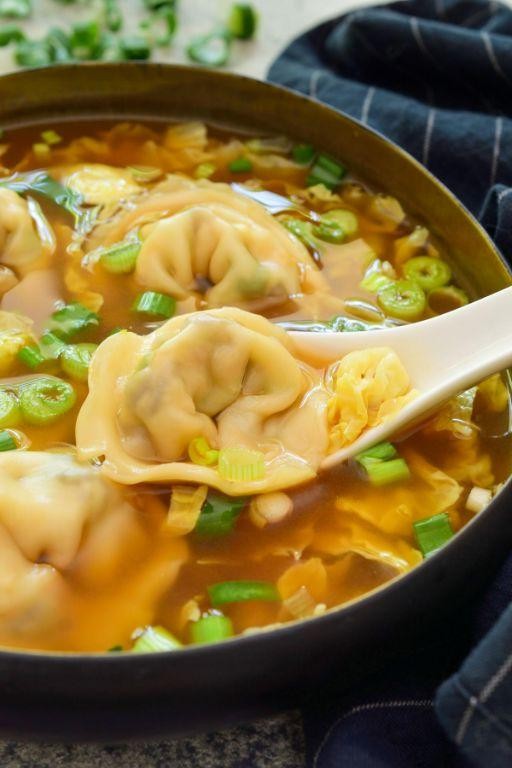
Holding the warm bowl between my palms, I remember how this vegan wonton soup became my quiet autumn companion—the steam rising like morning mist over still water, each delicate dumpling a vessel of comfort. Here, in this simple broth, I find the gentle rhythm of seasonal cooking that nourishes both body and spirit.
3
servings25
minutes20
minutesIngredients
– 1 package vegan wonton wrappers
– 8 oz firm tofu, pressed and crumbled
– ¼ cup shiitake mushrooms, finely minced
– 2 tbsp tamari
– 1 tsp toasted sesame oil
– 2 scallions, thinly sliced
– 1 tsp fresh ginger, microplaned
– 6 cups vegetable stock
– 1 sheet kombu (4-inch piece)
– ¼ cup mirin
– 1 tbsp white miso paste
– 2 cups baby bok choy, thinly sliced
Instructions
1. Combine crumbled tofu, minced shiitake mushrooms, tamari, toasted sesame oil, half the scallions, and microplaned ginger in a mixing bowl.
2. Place one vegan wonton wrapper on your work surface and spoon 1 teaspoon of filling into the center.
3. Moisten the edges of the wrapper with water using your fingertip, then fold diagonally to form a triangle, pressing firmly to seal.
4. Bring the two opposite points of the triangle together, overlapping them slightly, and press to adhere—this creates the classic wonton shape.
5. Repeat steps 2-4 until all filling is used, keeping completed wontons under a damp cloth to prevent drying.
6. In a large stockpot, combine vegetable stock and kombu, then bring to a gentle simmer over medium heat (180°F).
7. Remove and discard the kombu after 10 minutes of simmering—this extracts maximum umami without bitterness.
8. Whisk in mirin and white miso paste until fully dissolved, maintaining the broth below boiling to preserve delicate flavors.
9. Gently lower wontons into the simmering broth using a slotted spoon, cooking for 4-5 minutes until wrappers become translucent.
10. Add thinly sliced baby bok choy during the final minute of cooking, allowing it to wilt slightly while retaining crisp texture.
11. Ladle broth into bowls, distributing 6-8 wontons per serving and ensuring each portion includes bok choy.
12. Garnish with remaining scallions and drizzle with additional toasted sesame oil if desired.
Really, the magic happens in that first bite—the delicate wrapper gives way to savory filling while the clear broth carries subtle umami notes. I love serving this with a side of chili crisp for those who enjoy gentle heat, though the soup stands beautifully on its own as a light yet satisfying meal.
Sesame Tofu with Broccoli

Vividly remembering the gentle sizzle of sesame oil meeting hot cast iron takes me back to quiet Tuesday evenings, when simple ingredients transform into something deeply comforting. Sometimes the most nourishing meals emerge from these unplanned moments in the kitchen, where tofu crisps at the edges and broccoli florets soak up every bit of savory sauce.
3
servings25
minutes15
minutesIngredients
– 1 block extra-firm tofu, pressed and cubed
– 2 cups broccoli florets, trimmed to uniform size
– 3 tablespoons toasted sesame oil, divided
– 2 tablespoons tamari
– 1 tablespoon rice vinegar
– 2 teaspoons maple syrup
– 2 cloves garlic, microplaned
– 1 teaspoon fresh ginger, finely grated
– 1 tablespoon cornstarch
– 2 tablespoons sesame seeds
– ¼ cup filtered water
Instructions
1. Press the tofu block between paper towels with a heavy skillet for 20 minutes to remove excess moisture, then cut into 1-inch cubes.
2. Whisk together 2 tablespoons toasted sesame oil, tamari, rice vinegar, maple syrup, microplaned garlic, and grated ginger in a small bowl until fully emulsified.
3. Toss tofu cubes with cornstarch in a medium bowl until each piece develops a fine, even coating.
4. Heat remaining 1 tablespoon sesame oil in a large cast-iron skillet over medium-high heat until shimmering but not smoking.
5. Arrange tofu cubes in a single layer in the hot skillet, ensuring they don’t touch for proper browning.
6. Sear tofu for 4-5 minutes per side until golden brown and crisp-edged, resisting the urge to move pieces during initial cooking.
7. Steam broccoli florets in a separate pan with ¼ cup filtered water for 3-4 minutes until bright green and tender-crisp, then drain completely.
8. Pour the prepared sauce mixture into the skillet with tofu, stirring gently to coat each piece.
9. Add steamed broccoli to the skillet and toss with tofu and sauce over low heat for 1 minute to combine flavors.
10. Sprinkle sesame seeds over the dish and cook for 30 seconds more until fragrant.
Fresh from the skillet, the tofu maintains a satisfying crispness against the tender broccoli, while the sauce creates a glossy sheen that clings perfectly to each element. For a beautiful presentation, serve over jasmine rice with extra sesame seeds scattered across the top, letting the warm nutty aroma fill your kitchen space.
Vegetable Chow Mein
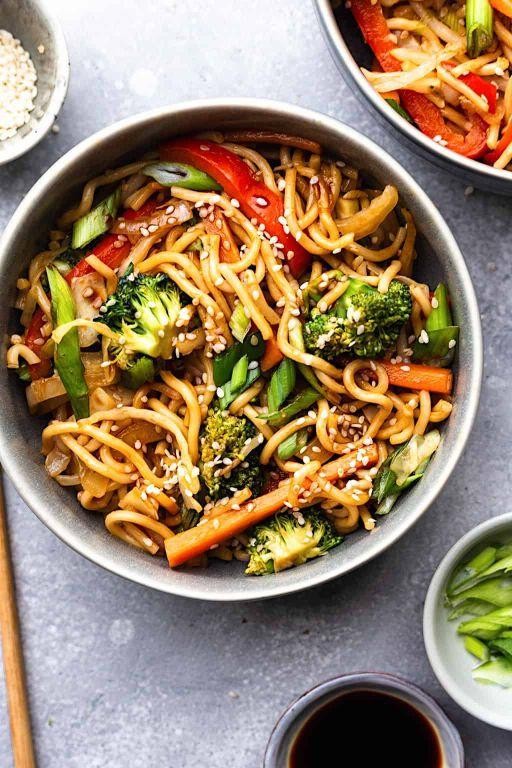
Holding this warm bowl of vegetable chow mein, I’m reminded how some of the most comforting meals emerge from the simplest, freshest ingredients. There’s something quietly profound about transforming humble vegetables and noodles into a dish that feels both nourishing and celebratory. This version has become my go-to when I need something that feeds both body and spirit.
3
servings15
minutes9
minutesIngredients
– 8 ounces fresh chow mein noodles
– 3 tablespoons cold-pressed sesame oil, divided
– 2 large pasture-raised eggs, lightly beaten
– 3 cloves garlic, microplaned
– 1 tablespoon freshly grated ginger
– 1 cup thinly sliced Napa cabbage
– 1 cup julienned carrots
– 1 cup snow peas, trimmed
– 3 tablespoons tamari
– 1 tablespoon mirin
– 1 teaspoon toasted sesame seeds
– 2 scallions, thinly sliced on the bias
Instructions
1. Bring 4 quarts of water to a rolling boil in a large stockpot.
2. Add chow mein noodles and cook for exactly 3 minutes until al dente.
3. Drain noodles immediately and rinse under cold running water to stop the cooking process.
4. Toss drained noodles with 1 tablespoon sesame oil to prevent sticking.
5. Heat a large wok over high heat until a drop of water sizzles and evaporates instantly.
6. Add 1 tablespoon sesame oil and swirl to coat the wok surface evenly.
7. Pour beaten eggs into the center of the wok and cook for 45 seconds until set but still slightly runny.
8. Remove eggs to a plate and slice into thin ribbons.
9. Add remaining sesame oil to the wok, maintaining high heat.
10. Sauté microplaned garlic and grated ginger for exactly 15 seconds until fragrant but not browned.
11. Add julienned carrots and stir-fry for 2 minutes until slightly softened.
12. Incorporate Napa cabbage and snow peas, cooking for another 90 seconds until vegetables are crisp-tender.
13. Return noodles to the wok, tossing continuously to combine with vegetables.
14. Drizzle tamari and mirin around the edges of the wok, allowing the liquids to caramelize slightly.
15. Add egg ribbons back to the wok, gently folding to distribute evenly.
16. Cook for 1 final minute, ensuring all components are heated through and well incorporated.
17. Remove from heat and garnish with toasted sesame seeds and sliced scallions.
Unfolding layers of texture make each bite of this chow mein uniquely satisfying—the slight chew of properly cooked noodles against the crisp vegetables, all bound by that subtle umami richness. I love serving it in wide, shallow bowls where the colors can really shine, sometimes topping it with extra scallions for that fresh, oniony crunch that cuts through the deeper flavors.
Vegan Dan Dan Noodles
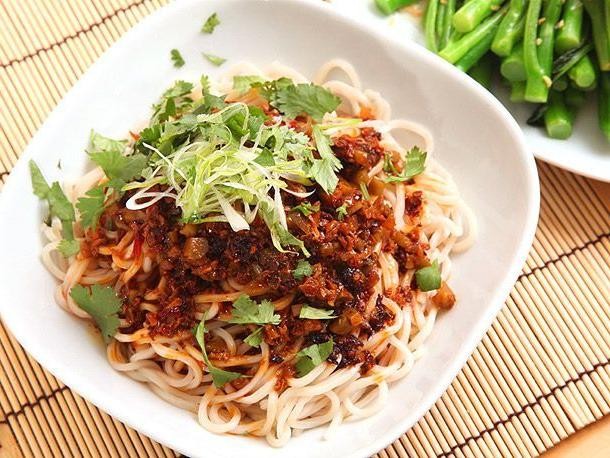
Folding the soft wheat noodles into the rich, savory sauce feels like tracing old memories with new hands. There’s something quietly comforting about transforming simple plant-based ingredients into this complex tapestry of textures and flavors. Each component whispers its own story before blending into the harmonious whole we know as vegan Dan Dan noodles.
2
servings15
minutes11
minutesIngredients
– 8 ounces fresh wheat noodles
– 2 tablespoons toasted sesame oil
– 3 cloves garlic, minced
– 1 tablespoon freshly grated ginger
– 8 ounces textured vegetable protein crumbles
– 2 tablespoons Sichuan peppercorns, lightly crushed
– ¼ cup creamy tahini paste
– 2 tablespoons black vinegar
– 1 tablespoon maple syrup
– 3 tablespoons tamari
– ½ cup vegetable broth
– 2 scallions, thinly sliced
– 1 tablespoon chili oil
– ¼ cup roasted peanuts, crushed
Instructions
1. Bring 4 quarts of water to a rolling boil in a large stockpot.
2. Add fresh wheat noodles and cook for precisely 3 minutes, stirring occasionally to prevent sticking.
3. Drain noodles immediately and rinse under cold running water for 30 seconds to stop the cooking process.
4. Toss drained noodles with 1 tablespoon toasted sesame oil to prevent clumping.
5. Heat remaining 1 tablespoon toasted sesame oil in a large wok over medium-high heat until shimmering.
6. Add minced garlic and grated ginger, sautéing for 45 seconds until fragrant but not browned.
7. Incorporate textured vegetable protein crumbles, stirring constantly for 2 minutes until lightly toasted.
8. Add crushed Sichuan peppercorns and cook for 30 seconds to release their aromatic oils.
9. Whisk together tahini paste, black vinegar, maple syrup, and tamari in a small bowl until emulsified.
10. Pour the tahini mixture into the wok along with vegetable broth, stirring to combine completely.
11. Reduce heat to medium-low and simmer the sauce for 4 minutes until slightly thickened.
12. Add the prepared noodles to the sauce, tossing gently with tongs to coat evenly.
13. Divide noodles between two bowls and garnish with sliced scallions.
14. Drizzle ½ tablespoon chili oil over each serving.
15. Sprinkle crushed roasted peanuts generously over the top.
A delicate numbing sensation from the Sichuan peppercorns dances across the tongue, balanced by the creamy tahini and sharp black vinegar. The textured vegetable protein provides satisfying chewiness that mimics traditional ground pork beautifully. For an elegant presentation, serve in shallow ceramic bowls with extra chili oil and crushed peanuts on the side for customization.
Pineapple Fried Rice
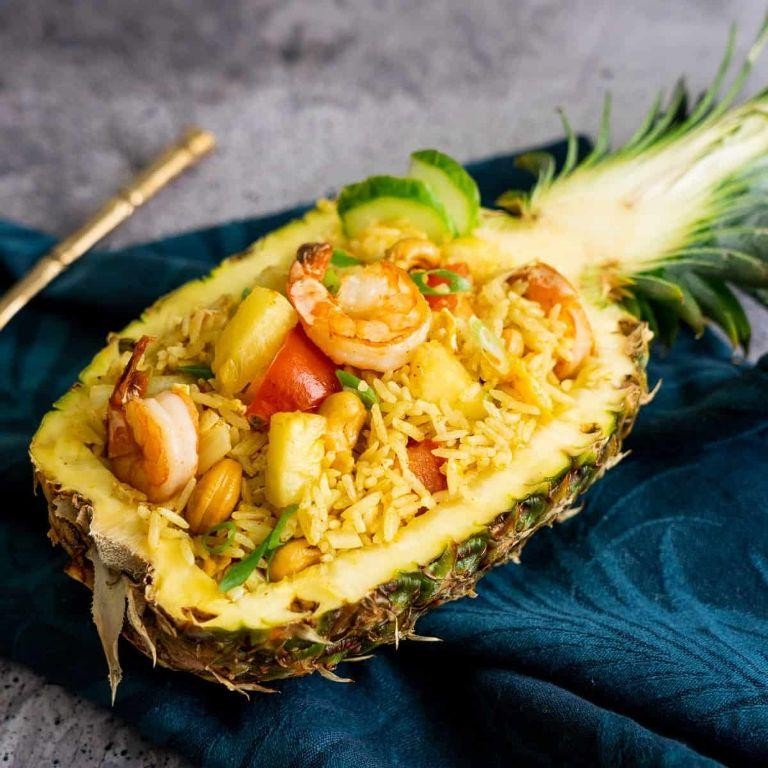
Remembering how the golden pineapple glistened in the afternoon light, I find myself drawn back to this humble dish that carries both tropical whispers and comforting warmth in every grain. Sometimes the simplest combinations hold the deepest memories, each bite unfolding like a quiet story told between sizzles and steam.
4
servings15
minutes15
minutesIngredients
– 2 cups day-old jasmine rice
– 1 cup fresh pineapple, diced into ½-inch cubes
– 8 ounces sustainably sourced shrimp, peeled and deveined
– 2 pasture-raised eggs, lightly beaten
– ½ cup sweet onion, finely minced
– ¼ cup cold-pressed avocado oil
– 3 tablespoons artisanal fish sauce
– 2 tablespoons raw coconut palm sugar
– 1 tablespoon freshly squeezed lime juice
– 1 teaspoon toasted sesame oil
– ½ cup roasted unsalted cashews
– ¼ cup fresh cilantro leaves, roughly torn
– 2 scallions, thinly sliced on bias
Instructions
1. Heat a 14-inch carbon steel wok over high heat until a drop of water evaporates within 2 seconds.
2. Pour 2 tablespoons cold-pressed avocado oil into the heated wok, swirling to coat the surface evenly.
3. Add 8 ounces sustainably sourced shrimp in a single layer, cooking for 90 seconds per side until opaque and lightly caramelized.
4. Transfer shrimp to a clean plate using tongs, ensuring no residual moisture remains in the wok.
5. Reduce heat to medium-high and pour remaining 2 tablespoons cold-pressed avocado oil into the wok.
6. Add ½ cup finely minced sweet onion, stirring constantly with a wok spatula for 3 minutes until translucent but not browned.
7. Push onions to the wok’s side and pour 2 lightly beaten pasture-raised eggs into the center space.
8. Scramble eggs for 45 seconds using quick circular motions until softly set but still moist.
9. Incorporate 2 cups day-old jasmine rice into the wok, breaking up clumps with the spatula’s edge.
10. Drizzle 3 tablespoons artisanal fish sauce and 2 tablespoons raw coconut palm sugar evenly over the rice mixture.
11. Toss ingredients vigorously for 4 minutes until each grain is separately coated and shimmering.
12. Fold in 1 cup fresh pineapple cubes and ½ cup roasted unsalted cashews, heating through for 2 minutes.
13. Remove wok from heat and stir in 1 tablespoon freshly squeezed lime juice and 1 teaspoon toasted sesame oil.
14. Gently incorporate reserved shrimp, ¼ cup roughly torn fresh cilantro leaves, and 2 thinly sliced scallions.
15. Let the fried rice rest off heat for 3 minutes to allow flavors to meld before serving.
Maybe it’s the way the warm rice yields to the crisp cashews, or how the sweet pineapple suddenly gives way to the umami depth of fish sauce—this dish feels like discovering hidden patterns in familiar things. Serve it in hollowed pineapple halves for a playful presentation that makes ordinary evenings feel like tropical escapes, the ceramic spoon clicking against the rough pineapple skin as you scoop up the final savory-sweet bites.
Crispy Orange Tofu
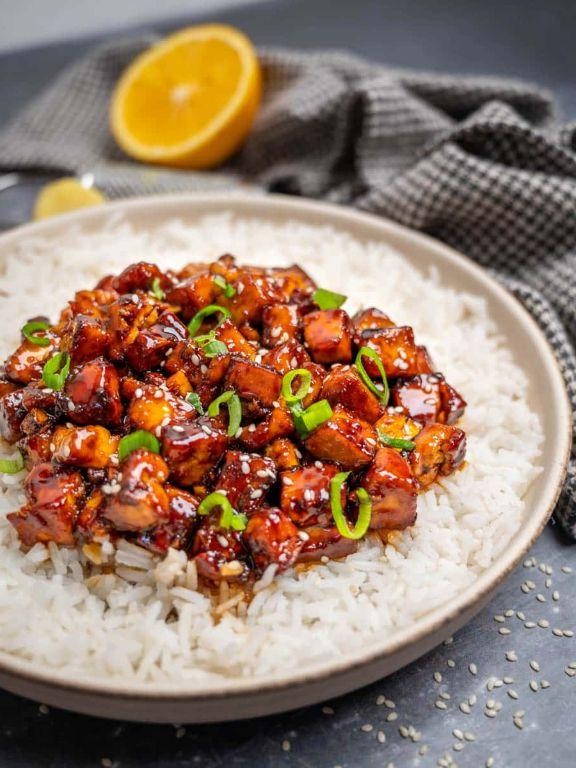
Vividly remembering the first time I tasted this dish at a quiet corner restaurant, the memory still warms me like afternoon sunlight through kitchen windows. There’s something profoundly comforting about the way sweet and savory notes dance together in this vegetarian interpretation, creating a symphony that feels both familiar and wonderfully new. Perhaps it’s the contrast of textures—the crisp exterior giving way to tender interior—that makes this recipe feel like such a personal discovery.
5
servings40
minutes15
minutesIngredients
– 1 pound extra-firm tofu, pressed and cubed
– ¾ cup cornstarch
– ½ cup high-smoke-point vegetable oil (such as avocado or peanut)
– 3 cloves garlic, finely minced
– 1 tablespoon freshly grated ginger
– ¾ cup freshly squeezed orange juice
– ¼ cup rice vinegar
– 3 tablespoons tamari
– 2 tablespoons light brown sugar
– 1 teaspoon toasted sesame oil
– 2 teaspoons orange zest
– 2 scallions, thinly sliced
– 1 teaspoon toasted sesame seeds
Instructions
1. Press the tofu between paper towels with a heavy plate for 30 minutes to remove excess moisture, then cut into 1-inch cubes.
2. Dredge each tofu cube thoroughly in cornstarch, ensuring all surfaces are evenly coated.
3. Heat vegetable oil in a heavy-bottomed skillet to 350°F, verified using a deep-fry thermometer.
4. Carefully lower tofu cubes into the hot oil using tongs, working in batches to avoid crowding.
5. Fry tofu for 4-5 minutes until golden brown and crisp, turning occasionally for even coloring.
6. Transfer fried tofu to a wire rack set over a baking sheet to drain, which preserves crispness better than paper towels.
7. Pour off all but 1 tablespoon of oil from the skillet, then return to medium heat.
8. Sauté minced garlic and grated ginger for 45 seconds until fragrant but not browned.
9. Whisk together orange juice, rice vinegar, tamari, and brown sugar in a small bowl until sugar dissolves completely.
10. Pour the sauce mixture into the skillet and bring to a simmer over medium-high heat.
11. Cook the sauce for 3-4 minutes until it thickens enough to coat the back of a spoon.
12. Stir in toasted sesame oil and orange zest off the heat to preserve their delicate flavors.
13. Gently fold the crispy tofu into the sauce until each piece is evenly glazed.
14. Garnish with sliced scallions and toasted sesame seeds immediately before serving.
Last night, I discovered this dish tastes particularly wonderful when served over jasmine rice that’s been cooled slightly, as the warmth contrast makes the crispy coating snap delightfully. The orange glaze clings to each tofu cube like morning dew, creating bursts of bright citrus that give way to savory depth with every bite.
Conclusion
Deliciously diverse, these 28 vegan Chinese recipes bring authentic flavors to your kitchen with plant-based ease. From savory stir-fries to comforting soups, there’s something for every craving. We’d love to hear which dishes become your favorites—drop a comment below! Don’t forget to pin your top picks on Pinterest to share these tasty discoveries with fellow food lovers. Happy cooking!
